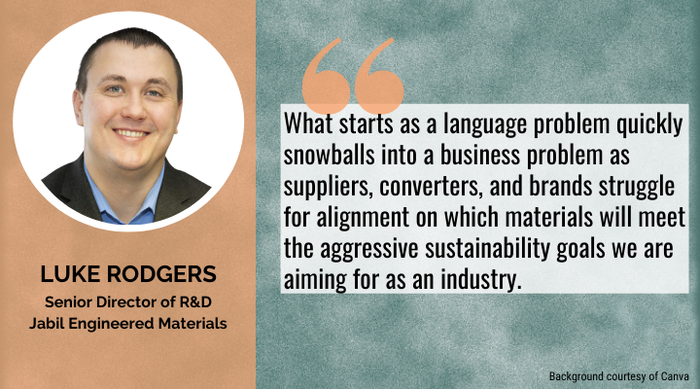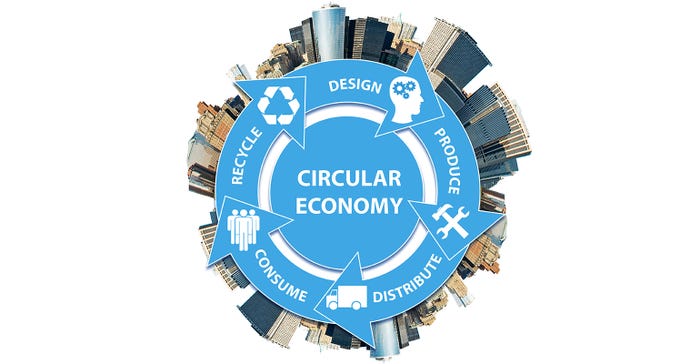Essentials of Compostable, Biodegradable, and Bioplastic Packaging
Jabil Engineered Materials' Senior Director of R&D Luke Rodgers brings clarity to this confusing area of packaging sustainability.
February 23, 2022

Are you confused about certain aspects of packaging sustainability? You’re not alone. One of the most perplexing areas of sustainability is the intersection of compostable, biodegradable, and bioplastic packaging.
And while these are among the most hotly debated topics in the circular economy discussion, they are not synonymous.
Packaging materials made from plant-based sources are not inherently compostable or biodegradable. Certain compostable materials originate from oil-based sources. And if a material is compostable, it’s not necessarily biodegradable.
The conversation gets confusing quickly, and important messages about how to properly dispose of packaging gets lost in the noise — leaving sustainability efforts to go to waste if consumers are not properly educated.
While it doesn’t necessarily take a scientist to understand the nuances of the various hues of “green” in the sustainability spectrum, it doesn’t hurt, either. Luke Rodgers, the senior director of research and development for Jabil Engineered Materials, sorts through the differences and distinctions of these three essential terms.
Tell our readers a little about yourself.
Rodgers: I have more than 10 years of experience in additive manufacturing and 20 granted patents in the technology space. At Jabil’s Materials Innovation Center in Chaska, MN, my team of scientists and engineers work every day to develop custom additive and injection molding materials, including compostable and biodegradable materials.
Let’s set things up by defining these key terms.
Rodgers: Bioplastics are made from natural materials, most commonly sugars like starches, cellulose, or lactic acid. They can also be created from soybeans, corn, algae, feathers, or wood. Corn is used to make the most common bioplastic, polylactic acid (PLA). Potatoes, canola, or corn are typically used to create polyhydroxyalkanoates (PHA), another popular bioplastic. Natural materials can also be fermented to form bio-based versions of traditionally oil-based plastics, for example bio-PET.
Compostable materials break down naturally over time into a nutritious fertilizer using fungi, bacteria, insects, worms, and other organisms. There are two different types of compostable materials — home compostable and industrial compostable. Home compostable materials can degrade in ambient temperatures alongside food scraps, grass clippings, leaves and other organic materials. To be certified “home compostable,” a material must degrade (physically break down) within six months and form compost (chemically break down) within 12 months.
Industrial compostable materials need higher temperatures and specific levels of carbon, oxygen, and nitrogen to degrade. However, they break down faster; certified industrial compostable materials must biodegrade and form compost within 180 days.
Finally, biodegradable materials can break down into natural materials in soil or water without outside intervention. Certified landfill biodegradable materials must be able to degrade anaerobically, or without oxygen. To meet the marine biodegradable standard, materials must physically break down in three months and biodegrade in six months within water.
There are a few key differences between compostable and biodegradable materials. Compostable materials cannot degrade without oxygen, unlike landfill biodegradable materials, or in water, like marine biodegradable plastics. Similarly, due to the environments in which they break down, biodegradable materials cannot form compost.

Tell us about why these terms are not synonymous.
Rodgers: Compostable materials, biodegradable materials, and bioplastics are often grouped together under one general “sustainable” umbrella. Consumers, and even those in the packaging industry, have the misconception that they are all made from natural materials and thus degrade into natural materials at the end of their life.
In reality, these terms refer to two separate, but connected, sustainability conversations: sustainable resource management and sustainable waste management.
Bioplastics are an example of the first — where did the material come from? — while compostable and biodegradable materials are examples of the second — what happens to the material at its end-of-life?
There is overlap between the two streams, but they are not mutually inclusive. For example, while bioplastics are typically biodegradable in their original form, the engineering required to create packaging that meets the needs of a brand owner often eliminates the material’s ability to biodegrade. The perception that all bioplastic packaging is biodegradable is common, but incorrect.
However, using materials science, it’s possible to engineer bioplastic packaging that maintains its biodegradability. On the other hand, it’s often believed that all compostable or biodegradable packaging is made from bioplastics, but it’s commonly generated from traditional petrochemicals.
How big a problem is this terminology confusion?
Rodgers: What starts as a language problem quickly snowballs into a business problem as suppliers, converters, and brands struggle for alignment on which materials will meet the aggressive sustainability goals we are aiming for as an industry. For example, most companies are looking for ways to reduce greenhouse gas (GHG) emissions throughout their supply chain. Bioplastics can require less carbon to produce than oil-based plastics — at times even offsetting the carbon generated during packaging production. However, the Scope 3 emissions involved in their harvesting and transportation can sometimes generate an even larger carbon footprint than traditional plastics. Scope 3 emissions are those not directly controlled by a company throughout their supply chain, from raw material harvesting to logistics and transportation. They are the largest portion of a brand's carbon footprint, generally accounting for up to 80%, or more, of greenhouse gas emissions.
And if industry insiders are confused by this subject, how can we expect consumers to buy into new materials and make the correct disposal decisions once a package reaches end-of-life?
Compostable and biodegradable plastics cannot be recycled. Any that end up in the recycling stream are thrown away. Thus, the sustainability benefits are negated, and plastic waste grows. Only 9% of plastic is recycled worldwide, so it’s imperative that any sustainable packaging efforts truly keep packaging out of landfills and waterways, not contribute to the problem.
What can industry professionals do?
Rodgers: Learning about the end-of-life properties as well as the sourcing and conversion challenges associated with bioplastics and biodegradable and compostable materials is the first step.
Next, brand owners must consider the requirements of their packaging. Are they solving for single-use food containers with food contamination or more durable personal care packaging that needs to be shower safe? Should the plastic be flexible or hold up to high heat? What about barrier protection?
A brand's sustainability goals also play a role in determining their choice of material. Are they looking to reduce their use of fossil fuels, improve the sustainability of their packaging’s end-of-life or both? These answers will help guide the final decision.
Brands also must ensure their packaging helps consumers close the loop with proper disposal instructions. Containers should clearly indicate whether they need to be recycled, composted — either in an industrial facility or in a home compost bin — or sent to a landfill.
These materials' environmental claims seem to resonate with consumers. Is that a good thing?
Rodgers: Most people really do want to recycle. But sometimes we engage in so-called "wish-cycling," where well-intentioned citizens throw anything into the bin without truly understanding if their municipality can handle it. When a municipal recovery facility (MRF) can't accept a material (which is often!), it is landfilled, defeating the purpose.
There is a growing percentage of people who understand this problem in the recycling infrastructure and want to regain some control over how they dispose of certain products.
Home-compostable products can be a great option for consumers who are educated on the issues and committed to disposing of their packaging in the greenest way possible.

Elnur/Adobe Stock
Please share best practices in these materials.
Rodgers: Any of these three options can fit into a sustainable packaging portfolio. Their unique properties require individual consideration, but with materials science and engineering, it is entirely possible to create packaging from organic materials that decomposes back into organic material, which then supports the creation of feedstock for new biopolymers — thus creating a circular economy.
Compostable packaging works best for products that have a shorter shelf life — approximately a year or less — and/or have any of the characteristics below:
A reusable design is not feasible.
The product cannot be easily recycled.
The product packaging becomes contaminated with food waste or will end up in organic waste collection.
There is infrastructure and regulation available for waste management of compostable materials in the product’s market.
A single-serve coffee pod is a great example of a potential compostable packaging application.
Biodegradable packaging is most suitable for products that need a lower degree of barrier protection and have short shelf lives. Soil biodegradable packaging could be a good option for brands in regions where recycling and composting infrastructure is underdeveloped.
In terms of function, bioplastics or bio-based plastics can essentially replace traditional oil-based plastics in most any use. Again, brands should consider the availability of recycling and compost facilities in their target markets to determine which type of bio- or bio-based plastic best fits their needs.
What’s a positive trend you’re seeing in sustainability?
Rodgers: Across the packaged goods landscape, we’re seeing brands taking steps toward their sustainable packaging goals with a particular focus on end-of-life. In the 2022 Sustainable Packaging Trends survey Jabil conducted with SIS International Research, 98% of respondents said they had taken some action toward sustainable packaging, with 23% already having a fully mature program. Compostable and biodegradable packaging are specifically of interest, with 48% of respondents saying they are incorporating or evaluating the use of compostable and biodegradable materials in their sustainable packaging programs. For 42% of participants, integrating these materials is their highest sustainable packaging priority, behind only the implementation of paper-based packaging.
Final thoughts?
Rodgers: Another interesting finding from our sustainable packaging survey is that brands are showing more willingness to bend on rigid product protection requirements for sustainability gains. In 2019, 81% of survey respondents said sustainable packaging options must include equal or greater product protection as non-sustainable options; only 68% said the same in 2021. This could indicate that consumers might be willing to trade a shorter product shelf life for the much more positive end-of-life story that compostable and biodegradable packaging offers.
You May Also Like


